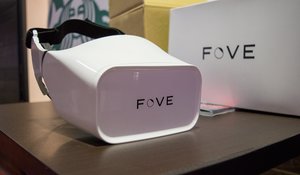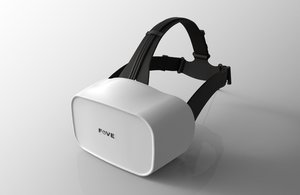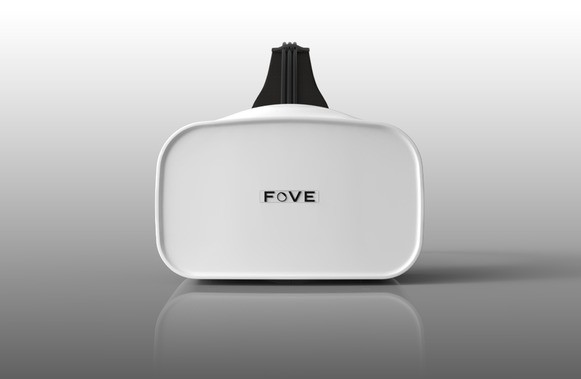FOVE Reveals Lightweight VR HMD Redesign
FOVE Inc., the creators of the FOVE eye-tracking VR HMD, revealed a new design for the in-development headset. The new kit has been re-engineered to reduce the overall weight. Full specs of the HMD are still to come.
We had a chance to catch up with FOVE Inc.’s CTO, Lochliam Wilson, and try out the early prototype of the hardware at CES earlier this year. Wilson told us that a new headset design would be revealed in “the coming months.” We were under the impression that he was hinting at GDC, but it turns out the announcement was made at SIGGRAPH 2016.
FOVE isn’t saying much about the specs of the hardware yet. All we know so far is that the new FOVE HMD is lighter and more compact than the prototype we tested in January. The older hardware was designed with a rigid strap system and deep side walls that wrap around your face. I found the mechanism that holds the HMD in place on your head to be comfortable and easy to use, but apparently, my feedback wasn’t common.
In reaction to user feedback, FOVE decided to eliminate the rigid strap mechanism in exchange for a fabric three-point harness that is similar to other VR HMD designs. Switching to a fabric strap system also eliminated the need for the deep side walls (the sidewalls housed the strap’s hinge system).


As a result, the size and weight of the updated FOVE HMD have been “dramatically reduced” from the previous iteration. The lighter weight also “dramatically improved overall wearability,” and the smaller, simpler design is better suited for efficient production.
FOVE didn’t get into the technical specifications of the hardware, but in a press release, the company did implore us to “hang on for a couple more days, and we’ll get back to you with a full July update.” Hopefully, the company will talk about its in-house tracking system. FOVE was going to use Valve’s Lighthouse system, but waiting for Lighthouse access would delay the production even further than it has already slipped, so FOVE is building its own solution.
Get Tom's Hardware's best news and in-depth reviews, straight to your inbox.
Kevin Carbotte is a contributing writer for Tom's Hardware who primarily covers VR and AR hardware. He has been writing for us for more than four years.
-
WFang I wonder if cost and manufacturing considerations was the real reason they dropped the side-walls and hinges.. not feedback that the old design was uncomfortable.. nobody outside the company will know for sure.Reply
Also, Steam/HTC must have been dicks for it to be true that using their lighthouse setup would "delay" them more than developing an in-house solution (complete with software, firmware, hardware and API developments)? -I mean, lighthouse is on the market and shipping and has been available to consumers for a couple of months already.. how on earth would that have 'further delayed' them? -
kcarbotte Reply18347439 said:I wonder if cost and manufacturing considerations was the real reason they dropped the side-walls and hinges.. not feedback that the old design was uncomfortable.. nobody outside the company will know for sure.
Also, Steam/HTC must have been dicks for it to be true that using their lighthouse setup would "delay" them more than developing an in-house solution (complete with software, firmware, hardware and API developments)? -I mean, lighthouse is on the market and shipping and has been available to consumers for a couple of months already.. how on earth would that have 'further delayed' them?
Valve wasn't working with them to license the tech until the Vive shipped.
Fove made the decision in February that it was already taking to long.
To our knowledge, Valve has not yet licensed the Lighthouse tech to any other companies and the developer kits for adding lighthouse trackers to peripherals aren't available yet.
-
grimfox The lighthouses are pretty basic technology. They don't emit a coded signal, to my knowledge, they just produce a spinning plane of light. I'm not saying I would do it (mostly cause I'm lazy) but if you were properly motivated you could buy some and develop your tech based on interpreting the signal they produce. Certainly having the SDK could help, but I think a lot of the work would still have to be done to catch and time the signals that would not require the SDK, hardware level stuff. To each their own.Reply -
kcarbotte Reply18348092 said:The lighthouses are pretty basic technology. They don't emit a coded signal, to my knowledge, they just produce a spinning plane of light. I'm not saying I would do it (mostly cause I'm lazy) but if you were properly motivated you could buy some and develop your tech based on interpreting the signal they produce. Certainly having the SDK could help, but I think a lot of the work would still have to be done to catch and time the signals that would not require the SDK, hardware level stuff. To each their own.
It's not a coded signal, it's a pattern of infrared light that spins on an axis. Fove could probably do what you described, but I have to think that Valve's concept has a patent.
Valve has to give permission to other companies that want to use their tech. Fove can't just go out and buy some lighthouses and hack it together with their hardware and then sell it as a consumer product. They would be sued to oblivion for that.
FOVE, like Oculus and OSVR, is developing its own unique system.
